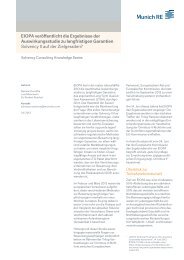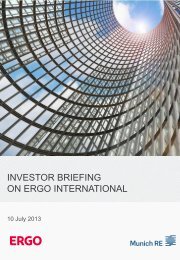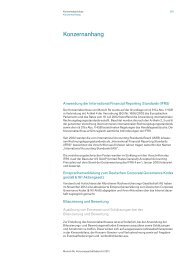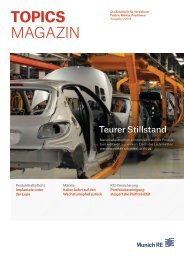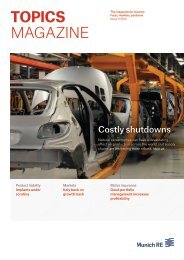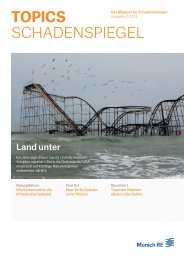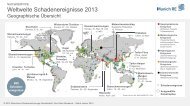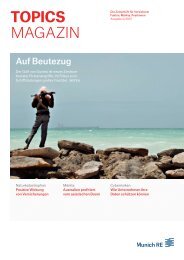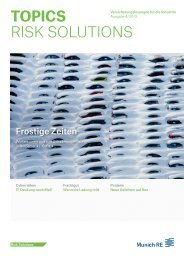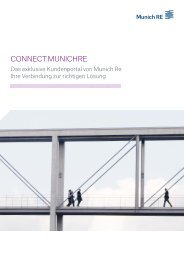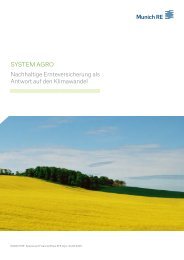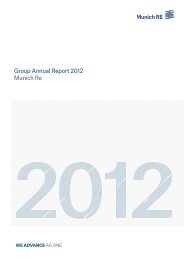Munich Re Group Annual Report 2006 (PDF, 1.8
Munich Re Group Annual Report 2006 (PDF, 1.8
Munich Re Group Annual Report 2006 (PDF, 1.8
Create successful ePaper yourself
Turn your PDF publications into a flip-book with our unique Google optimized e-Paper software.
<strong>Munich</strong> <strong>Re</strong> <strong>Group</strong> <strong>Annual</strong> <strong>Re</strong>port <strong>2006</strong> Management report_<strong>Munich</strong> <strong>Re</strong> <strong>Group</strong><br />
The products of life primary insurance and reinsurance,<br />
and the bulk of our health primary insurance business, are<br />
characterised by their long-term nature and the distribution<br />
of results over the duration of the policies. For valuing<br />
such long-term portfolios, whose performance cannot be<br />
reasonably measured on the basis of a single year, we use<br />
the European Embedded Value method. Embedded value<br />
is the present value of future net earnings from business in<br />
force plus the value of shareholders’ equity, less the cost of<br />
holding capital. All assets and liabilities are valued consistently<br />
with how financial markets price tradeable instruments<br />
(”market-consistent embedded value”). Policyholders’<br />
options and guarantees are explicitly taken into<br />
account using stochastic simulations. By setting a minimum<br />
return requirement, we aim through value-based<br />
management to ensure an adequate return on the capital<br />
employed and an appropriate value added.<br />
Our steering of <strong>Munich</strong> <strong>Re</strong>’s investments is strongly<br />
geared to the structure of the liabilities on our balance<br />
sheet. With the help of asset-liability management, we<br />
determine the “neutral position”. This involves a synthetic<br />
investment portfolio which – taking into consideration<br />
significant additional parameters in the investment of<br />
capital – best reflects the characteristics of our liabilities<br />
towards clients. Further information on asset-liability management<br />
is provided on page 98. The target return, i.e. the<br />
expected income from the neutral position, is compared<br />
with the return from the actual portfolio, bearing in mind<br />
the risk capital required for deviating from the neutral position.<br />
Finally, a comparison with the returns of relevant<br />
stock market indices provides important insights into the<br />
performance of our own investments.<br />
In addition to these purely financial performance<br />
factors, non-financial performance measures like market<br />
share, speed of processes, staff-training level and client<br />
satisfaction play a major part. In the long term, a firm can<br />
only be successful if it operates sustainably and takes<br />
account of such future-oriented qualitative factors as well.<br />
We closely link strategy and operative planning by<br />
defining our objectives in structured overviews or “scorecards”,<br />
from which we derive initiatives, performance<br />
measures and responsibilities within a framework of four<br />
perspectives: “financial”, “market and client”, “process”<br />
and “employee”. We promote an entrepreneurial culture<br />
among staff through the clear allocation of responsibility<br />
and accountability, recognising how much the individual,<br />
unit or field of business contributes to increasing value.<br />
The consistent integration of the financial and non-financial<br />
objectives into Board, executive and staff incentive systems<br />
supports the clear orientation towards value creation.<br />
In order to give more emphasis in external communication<br />
to the <strong>Munich</strong> <strong>Re</strong> <strong>Group</strong>’s value orientation – as<br />
widely implemented through our internal management<br />
tools – we have geared our <strong>Group</strong> return target to riskadjusted<br />
performance indicators, which are explained in<br />
more detail below.<br />
What we aim to achieve<br />
Starting point <strong>2006</strong><br />
In the past year, the <strong>Munich</strong> <strong>Re</strong> <strong>Group</strong>’s business performed<br />
very well. Thanks to the excellent business experience in<br />
reinsurance, the gratifying performance in primary insurance<br />
and the very good investment result, we recorded an<br />
outstanding consolidated profit of over €3.5bn. We achieved<br />
a return of 20.3% on our risk-adjusted capital, thus surpassing<br />
our target of 15%. Our return on investment was a<br />
very satisfying 5.0% (5.9%). This is the ratio of the investment<br />
result of €8.9bn to the average market value of the<br />
investment portfolio at the balance sheet and quarterly<br />
reporting dates, totalling €178bn.<br />
Our combined ratio, a much-heeded performance indicator<br />
in property-casualty insurance, was convincing in<br />
both reinsurance and primary insurance. For better comparability,<br />
we divide the combined ratio into property-casualty<br />
and health. The combined ratio in property-casualty<br />
includes all the business attributable to this segment,<br />
whereas in health it refers only to health insurance that is<br />
not conducted like life insurance. Calculated as the percentage<br />
ratio of the sum of net expenses for claims and<br />
benefits plus net operating expenses to net earned premiums,<br />
the combined ratio corresponds to the sum of the<br />
loss ratio and the expense ratio. Put simply, a combined<br />
53



